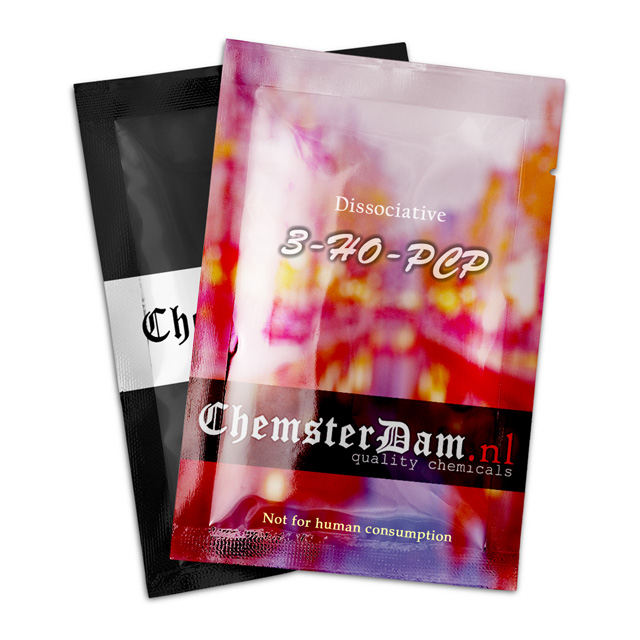| property | value |
|---|---|
| Common names | 3-HO-PCP, Hydroxyphencyclidine |
| Substitutive name | 3-Hydroxyphencyclidine |
| Systematic name | 3-(1-Piperidin-1-ylcyclohexyl)phenol |
| Psychoactive class | Dissociative,Opioid |
| Chemical class | Arylcyclohexylamine |
3-hydroxyphencyclidine (commonly known as 3-ho-pcp) is a novel dissociative substance of the arylcyclohexylamine class that produces potent dissociative, hallucinogenic and euphoric effects when administered. in addition to its primary activity as a nmda receptor antagonist, it has been found to have appreciable affinity for the μ-opioid receptor.
3-ho-pcp was first synthesized in 1978 to investigate the structure-activity relationship of phencyclidine (pcp) derivatives. it was further explored alongside pcp in the 1980s, where it was discovered to possess μ-opioid agonist activity in animal models.
like other substances of its class, particularly methoxetamine (mxe), phencyclidine (pcp), and 3-meo-pce, it is known to primarily induce a state referred to as “dissociative anesthesia“, albeit the extent to which this occurs has been reported to be highly dose-dependent and variable in its effects. it is unknown whether the studied opioid properties in animal models applies to humans, with some early reports suggesting that it does not.
there are also reports that suggest this compound may produce more physical side effects such as muscle soreness and flu-like symptoms during or shortly after administration. this suggests it may be uniquely more dangerous or toxic than related dissociatives, particularly at higher doses.
today, 3-ho-pcp is almost exclusively distributed as a gray area research chemical by online vendors. extremely little is known about its pharmacology, metabolism and toxicity in humans. due to its sensitive dose-response, potential habit-forming properties, as well as unknown toxicity profile, it is strongly recommended that one use proper harm reduction practices if choosing to use this substance.
history and culture
3-ho-pcp was first synthesized in 1978 to investigate the structure-activity relationship of phencyclidine (pcp) derivatives. it was further explored alongside pcp in the 1980s, where it was discovered to possess μ-opioid agonist activity in animal models.
its potential as a research chemical for human use was not suggested until 1999 when a chemist using the pseudonym john q. beagle reported on its significantly increased potency relative to pcp as well as its “profoundly enhanced affinity for the opiate receptor” which was estimated to give it analgesic activity one order of magnitude lower than morphine.
on october 18, 2012, the advisory council on the misuse of drugs in the united kingdom released a report about methoxetamine, saying that the “harms of methoxetamine are commensurate with class b of the misuse of drugs act (1971)”, despite the fact that the act does not classify drugs based on harm. the report suggests that all analogs of mxe should also become class b drugs and suggested a catch-all clause covering both existing and unresearched arylcyclohexamines, including 3-ho-pcp.
chemistry
3-ho-pcp, or 3-hydroxyphencyclidine, is a synthetic dissociative of the arylcyclohexylamine class. the structure of 3-ho-pcp is comprised of cyclohexane, a six-member saturated ring, bonded to two additional rings at r1. one of these rings is a piperidine ring, a nitrogenous six member ring, bonded at its nitrogen group. the other ring is an aromatic phenyl ring, substituted at r3 with a hydroxy group.
3-ho-pcp is a structural analog of pcp and a homolog 3-meo-pcp.
pharmacology
like other arylcyclohexylamine dissociatives, 3-ho-pcp acts principally as an nmda receptor antagonist.
the nmda (n-methyl-d-aspartate) receptor, a specific subtype of the glutamate receptor, modulates the transmission of electrical signals between neurons in the brain and spinal cord; for the signals to pass, the receptor must be open. dissociatives inhibit the normal functioning nmda receptors by binding to and blocking them. this disruption of neural network activity causes network disintegration, some research suggests, by hyperconnectivity throughout the brain. this causes an increase in noise (random, nonsensical and erraneous data) on the cerebral network and thus produces loss of normal cognitive and affective processing, psychomotor functioning, anesthesia. this is often observed in those showing psychosis or induced with high-dose iv thc or ketamine in healthy participants, please see references.
unlike many other dissociatives, 3-ho-pcp has also been found to have appreciable affinity as a μ-opioid receptor agonist in animal models. however, the extent to which this applies to humans remains unknown.


Frederick –